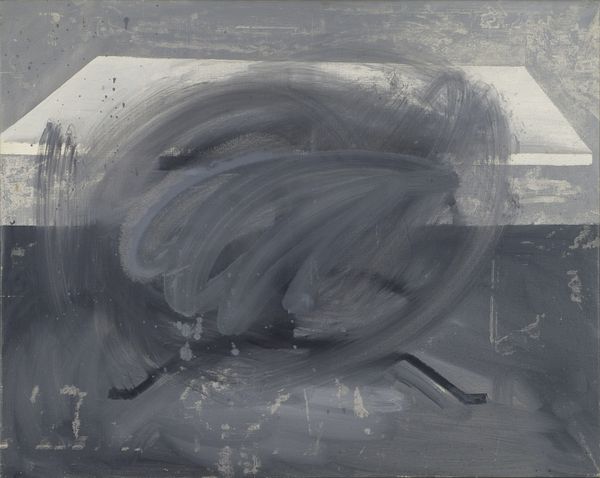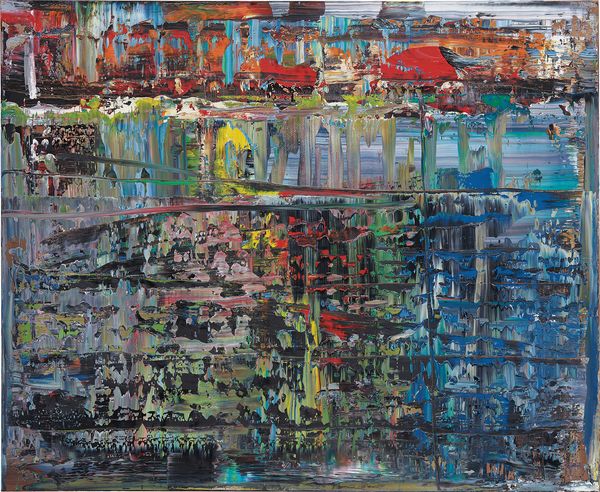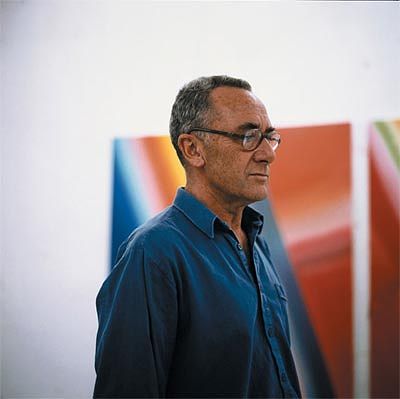Gerhard Richter Abstraktes Bild (714-1), 1990
Gerhard Richter's Abstraktes Bild (714-1) is a stunning example from the artist's corpus of abstract paintings that was most recently highlighted in Gerhard Richter – Abstraktion, an acclaimed exhibition at the Museum Barberini in Potsdam. A brilliant spectrum of color emerges from darkness — flashes of red, yellow, blue and green burst forth like molten lava erupting from inky depths. Painted in 1990, it dates from the finest period of Richter's abstractions to date and celebrates his mastery of the squeegee technique, widely considered one of his greatest contributions to art history.
The period in Richter’s career in which Abstraktes Bild was created – at the turn of 1980s – was a transformational chapter in his oeuvre and his global reception. In 1989, his exhibition October 18, 1977 travelled from Germany to several important international institutions, including the Institute of Contemporary Art London and the Montreal Museum of Fine Arts. Concurrently, he was subject to a major exhibition at the Museum Boymans-van Beuningen in Rotterdam in 1989. With this international acclaim, as well as increasing value of his works, also came considerable pressure and Richter decided to take some time off from the exhibition circuit. Postponing several projects, he retrieved to his studio to focus on painting, writing in his journal on August 16, 1990, “so as to have a whole year to ‘evolve’ something without commitments.”
Richter's process has been likened to that of a pendulum, swinging between phases of chance and control until the desired composition is achieved.
Gerhard Richter, 1990. Photo Manfred Leve © Manfred Leve
Works such as the painting from our 20th Century & Contemporary Art Evening Sale in New York, which Richter created in 1990, saw him further develop his revolutionary squeegee technique. The sense of ease and spontaneity that radiates from this painting belies Richter's famously laborious and complex working method. Indeed, it would have undergone multiple variations whereby Richter would repeatedly apply, erase, remake and obliterate the various paint strata — each addition and effacement introducing new chromatic and textural juxtapositions. Richter's process has been likened to that of a pendulum, swinging between phases of chance and control until the desired composition is achieved.
Richter had begun exploring the squeegee technique in the 1980s, but an early precedent can already be found in the haptic swirls of paint that canceled out the photorealistic images in his early work, such as (Tisch) Table, 1962. This canceling-out of the photorealistic image demonstrates a keen fascination with the relationship between figuration and abstraction, one that also informs Richter's Abstrakte Bilder.

Gerhard Richter (Tisch) Table, 1962
The Abstrakte Bilder Richter started creating in the 1980s are ostensibly informed by this dual interest in figuration and abstraction, with the artist conceiving both figurative and abstract work in tandem. This engagement with both abstraction and figuration reflects the interrelationship of what Dietmar Elger in the recent Museum Barberini exhibition catalog described as "two sides of the same coin."
Almost all the abstract paintings show scenarios, surroundings and landscapes that don't exist, but they create the impression that they could exist. As though they were photographs of scenarios and regions that had never yet been seen. — Gerhard Richter
Richter considers both figurative and abstract paintings as equal analogies for the reality surrounding us: colors and proportions. Looking at Abstraktes Bild equally gives rise to the sensation of looking into the abyss of an otherworldly, half-seen or remembered out-of-focus image.
As such, it vividly conveys Richter's notion of reality as a simulation — an investigation that would notably usher in the development of his discrete Mirror series, which tellingly debuted alongside the Abstrakte Bilder.

